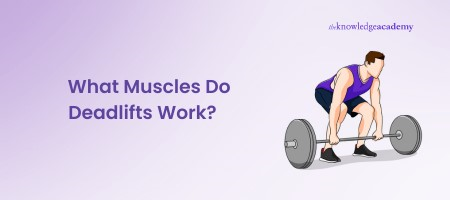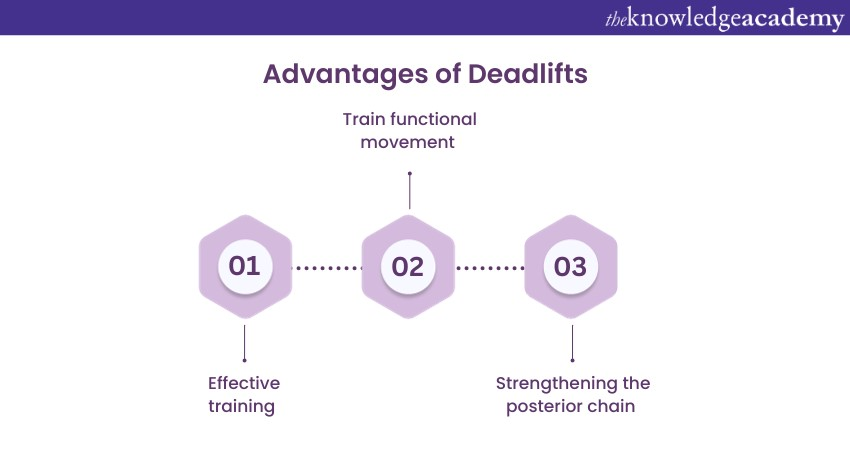We may not have the course you’re looking for. If you enquire or give us a call on 01344203999 and speak to our training experts, we may still be able to help with your training requirements.
Training Outcomes Within Your Budget!
We ensure quality, budget-alignment, and timely delivery by our expert instructors.

Even if you haven't entered a gym before, chances are you have executed a Deadlift or at least engaged in the fundamental movements characterising this classic compound exercise. Whether you've leaned over to lift your child or pet, reached down to retrieve groceries, or bent to access items in a low cabinet, you have tasted the foundational elements of deadlifting.
Deadlifts exhibit exceptional functional carryover compared to other conventional lifts. The mechanics and strength developed through deadlifting seamlessly transfer to our everyday activities, allowing us to lift objects from the ground efficiently and safely. Deadlifts are a highly effective exercise for building overall strength and Muscle mass, making them a cornerstone in many strength training. Read this blog to explore more about What Muscles do Deadlifts Work! Read more to learn more!
Table of Contents
1) How to do a Deadlift?
2) Determining the ideal Deadlift repetitions
3) Activated Muscles in Deadlifts
4) Advantages of Deadlifts
5) Conclusion
How to do a Deadlift?
A Deadlift comprises three stages: the setup, pull, and lockout. The following provides a breakdown of each phase:
The setup
Position yourself with feet hip-width apart. Emphasise engaging the core Muscles and contracting the shoulder blades downwards and together to activate the lats. If employing a barbell, ensure it's on the floor and in contact with the shins—hinge at the hips, maintaining a straight spine and elevated chest. Grasp the barbell using an over-under grip, with one hand facing palm-up and the other palm-down. Squeeze the bar and shift back into the hips.
The pull
Press the feet onto the floor, straighten the legs, and lift the chest and the weight. Thrust the hips forward and draw the knees backwards.
The lockout
Retract the shoulders and straighten the spine at the pinnacle of the movement. Pause briefly, then lower the barbell by pushing the hips back, employing thigh and core Muscles to decelerate the descent.
Recognising that correct form may vary among individuals based on their body type and capabilities is essential. For instance, individuals with limited hamstring flexibility might not descend as far as those with more supple hamstrings.
The weight and repetitions should align with an individual's fitness level and objectives. It is crucial to avoid overburdening oneself too quickly, especially before mastering the proper lifting technique.
For novices, prioritise form. Practice the Deadlift motion without added weight before introducing resistance to ensure proficiency in the technique.
Determining the ideal Deadlift repetitions
When determining the ideal number of repetitions for Deadlifts, it's essential to consider various factors. The optimal rep range often depends on individual fitness goals. A lower rep range (around 1-6 reps) might be suitable for strength gains, while higher rep ranges (8-12 reps) can contribute to Muscle hypertrophy. Endurance-focused training might involve even higher rep ranges. It's crucial to listen to your body, gradually increase intensity, and adjust the number of repetitions based on your specific objectives.
Improve your Nutrition and health with our Nutrition and Fitness Training - sign up now!
Activated Muscles in Deadlifts
Are you wondering What Muscles do Deadlifts Work? Let's deep dive into the Muscles at work with the following:
Engaging the glutes
Engaging the glutes is a foundational and crucial component of the deadlift. The gluteal Muscles, particularly the powerful gluteus maximus, play a pivotal role in the dynamic movement of hip extension during the upward phase of the lift. Proper activation of the glutes is essential for generating maximum power and contributes significantly to overall stability. This enhanced stability promotes a balanced and controlled deadlift, ensuring efficient force transfer through the kinetic chain.
Activating the hamstrings
The hamstrings are actively engaged throughout the deadlift, especially during the lifting phase. Working synergistically with the glutes, the hamstrings assist in hip extension, allowing for a smooth and powerful upward movement. Ensuring the proper activation of the hamstrings is critical for successfully executing the lift and fostering balanced Muscle development within the posterior chain. This comprehensive engagement contributes to the lower body's strength and aesthetics.
Strengthening the spinal erectors
The Muscles along the spine, known as the spinal erectors, play a vital role in maintaining an upright posture during Deadlifts. Strengthening these Muscles is essential for spinal stability throughout the entire range of motion. As the body hinges at the hips and lowers towards the ground, the spinal erectors prevent back rounding, reducing the risk of injuries. This strengthening aspect is crucial for building a resilient and well-supported spine.
Fortifying core and ab Muscles
Deadlifts serve as an excellent tool for fortifying the core and abdominal Muscles. The core's role in stabilising the spine must be balanced, and engaging the abdominals during Deadlifts contributes to overall trunk stability. This enhances performance by providing a solid foundation for the movement and reduces the risk of lower back strain. Core and ab strengthening integration make Deadlifts valuable to any functional fitness routine.
Lats in action
The latissimus dorsi (lats) Muscles come into play during Deadlifts to stabilise the spine and provide crucial support during the lifting phase. Developing strength in the lats is instrumental for maintaining proper form throughout the movement. This engagement contributes to the upper back's strength and the spine's overall stability, ensuring a controlled and efficient deadlift.
Traps in the Deadlift
The trapezius Muscles, particularly the upper traps, play a significant role in Deadlifts by providing stability to the upper back. Strengthening the traps is integral to achieving better posture and upper body strength. As the weight is lifted, the traps help prevent excessive forward lean, supporting a more upright and controlled deadlift. This makes Deadlifts valuable for targeting the upper back and promoting balanced Muscle development.
Fortifying forearms
Deadlifts place substantial demands on grip strength and forearm endurance, making them an effective exercise for fortifying these areas. A strong grip is essential for handling heavier weights, and the forearm strength developed during Deadlifts contributes to overall functional fitness. Additionally, improved forearm strength enhances performance in various daily activities that require grip and forearm endurance, making Deadlifts a practical and holistic exercise.
Are you eager to learn about essential life lessons? Sign up now for our Life Coach Masterclass!
Advantages of Deadlifts
Deadlifts are a compound exercise that provides many benefits for individuals seeking a well-rounded and effective workout routine.

Effective training
One of the primary advantages of incorporating Deadlifts into your training regimen is their efficiency. Deadlifts engage multiple Muscle groups simultaneously, making them a time-effective choice for those looking to maximise their workout in terms of time and Muscle activation. You can target major Muscle groups with a single exercise, including the back, hips, legs, and core.
Train functional movement
Deadlifts are renowned for their ability to mimic real-life movements, making them highly functional. The biomechanics involved in a Deadlift closely resemble activities such as picking up objects from the ground. By incorporating Deadlifts into your routine, you enhance your ability to perform everyday tasks properly and reduce the risk of injury. This functional aspect makes Deadlifts a valuable addition to any fitness program, contributing to overall physical preparedness.
Strengthening the posterior chain
The posterior chain, consisting of Muscles along the back of the body, is heavily engaged during Deadlifts. This includes the erector spine, glutes, hamstrings, and lats. Strengthening these Muscles improves posture, enhances athletic performance, and reduces the risk of lower back issues. The emphasis on the posterior chain makes Deadlifts an excellent exercise for achieving a well-balanced and robust physique.
Do you want to gain in-depth knowledge about Nutrition to improve your physical well-being? Sign up now for our Nutrition Training!
Conclusion
Mastering Deadlifts presents a formidable challenge. If you are a gym member, collaborate with a trainer or fitness expert. They can showcase the proper technique and observe your form to ensure accurate execution. After acquiring the correct format, incorporate Deadlifts into your regular exercise routine. However, you must consult your doctor before initiating a new fitness regimen. Hope you have understood What Muscles do Deadlifts Work!
Learn how to build a healthy life with our Active and Healthy Lifestyles Training - join now!
Frequently Asked Questions
Upcoming Health & Safety Resources Batches & Dates
Date
 Active and Healthy Lifestyles Training
Active and Healthy Lifestyles Training
Fri 31st May 2024
Fri 23rd Aug 2024
Fri 29th Nov 2024







 Top Rated Course
Top Rated Course



 If you wish to make any changes to your course, please
If you wish to make any changes to your course, please


